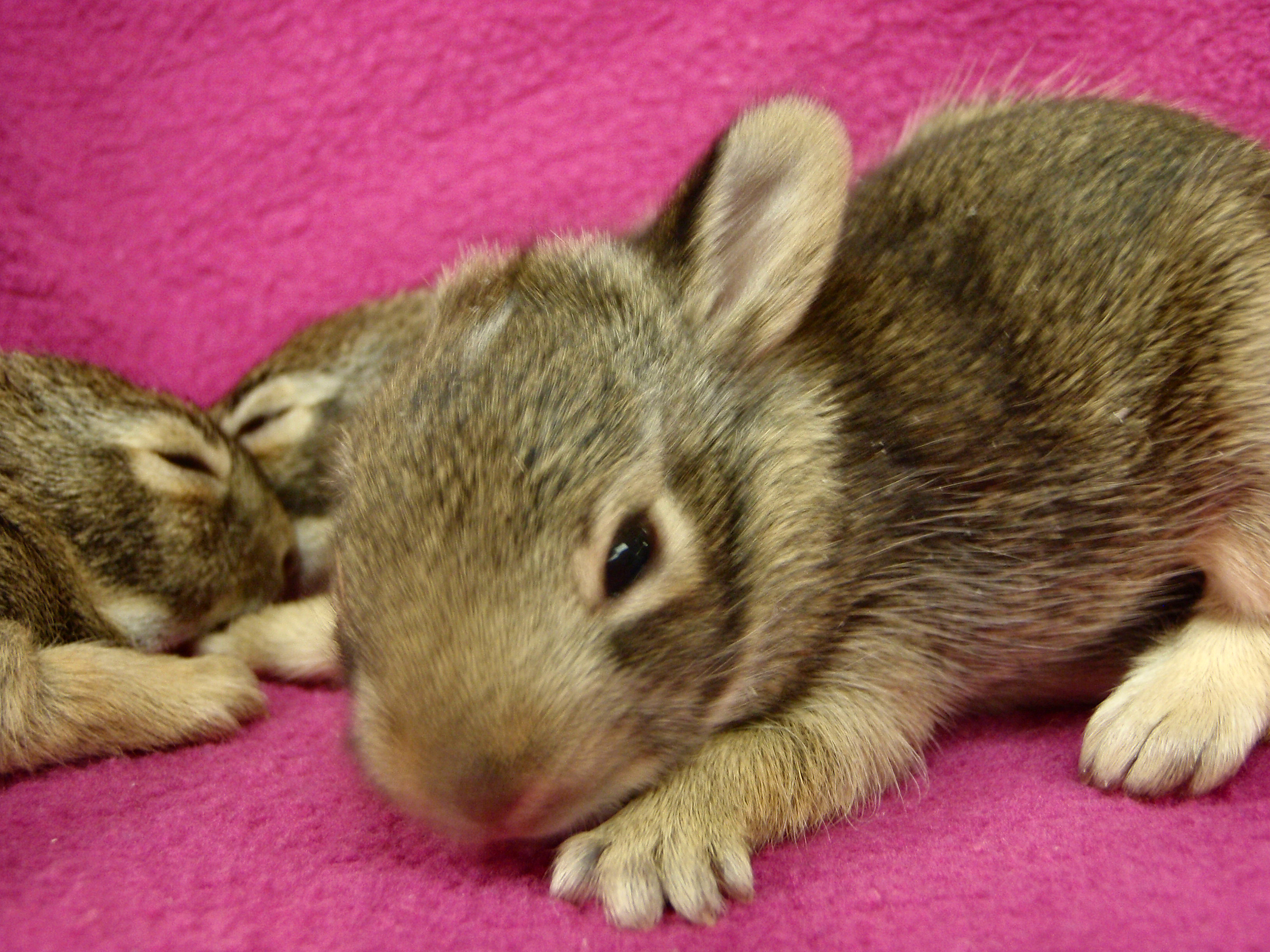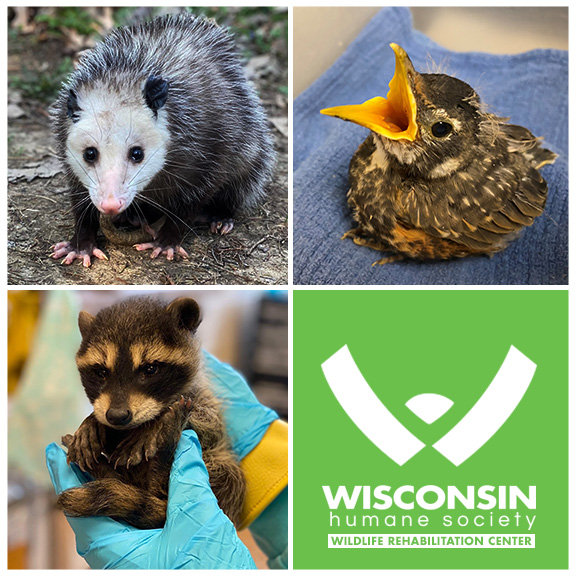Baby Cottontail Nests
Did you find a nest of baby cottontail bunnies with no mama in sight?
CLICK HERE for a print-friendly version and photos!
Description: Cottontails typically scrape out a shallow "pocket" in the soil for their nest. After giving birth, the mom rabbit covers her babies with some of her own fur and often some vegetation, such as dried grasses.
Location: The nest may be just about anywhere the mother can dig in the soil: in lawns, gardens, planters, under landscape shrubbery, on playgrounds, athletic fields, etc.
Maternal Care: To avoid attracting attention to her nest, the mother rabbit typically only visits the nest to feed her young at dawn and dusk. She will continue to nurse her young in the nest for about four weeks. By this time, the young bunnies will have already begun adventuring out of the nest to nibble nearby greenery. Surprisingly, the young rabbits become independent of their mother at about four to five weeks of age. At this time they are only four to five inches long.
Here are a few important tips to know:
- Mother rabbits visit their babies only twice a day – typically around dawn and dusk – to avoid attracting unwanted attention from predators in the area. Most seemingly “abandoned” babies are actually being watched closely by mom from a distance.
- If you find a rabbit’s nest in your yard and the babies are not injured, there’s a good chance they can stay there. No one can do a better job than mom, and there is no human-made formula that is nearly as good as what she provides. The only time a wildlife rehabilitator needs to get involved is if those babies are injured or truly orphaned.
- While you should do everything you can to avoid touching a bunny at all, much less with bare hands, a mother will *not* reject her babies because they have been touched by humans. If someone has already picked up a baby bunny and the baby appears healthy, please ask them to return the little one to the nest.
FAQs & Humane Solutions:
"I found a rabbit nest in my yard and I'm afraid one of my kids will step on it or we'll forget it is there and mow over it. Can I move the nest?"
No. The mother rabbit will not recognize the nest as her own if you relocate it, and the babies will be abandoned. Instead of relocating the nest, simply mark the location so you can mow around it until the babies leave the nest. Instruct children not to disturb the nest. Keep your pets away from the nest and use another pet exercise area for the few weeks it takes for the young bunnies to become mobile and leave the immediate area.
"I'm concerned that crows or my neighbor's cats or dog will get at the bunnies in the nest. What can I do to protect the babies?"
If you are concerned that crows, cats, dogs or children will harm the babies in the nest, you can try placing an empty, upside-down laundry basket over the nest during the daytime (see photo in PDF). You should weigh the basket down by placing a brick or other reasonably heavy object on top of the basket. The basket must be removed around dusk and left off all night so the mom rabbit can get to her nest to feed her young.
"I haven't seen the mother rabbit come to her nest to care for her babies; how can I tell if they have been abandoned?"
Because the mother rabbit typically only visits her nest at dawn and dusk, people very often assume that because they haven't seen the mother at the nest, that the young have been abandoned. To find out if a mom rabbit is still caring for her young, you can do "the Twig Test" (see photos in PDF). To do the Twig Test, place twigs or pieces of string in a criss-crossed, checkerboard pattern spaced 1-2" apart, over the nest in the afternoon or early evening. Check the nest the following morning. If the twigs have been disturbed, the mother is probably caring for the babies. If the twigs do not appear to have been disturbed, the babies may be orphaned. It is sometimes possible for the mom to feed her babies without appreciably disturbing the twigs. We know this because we have had people bring in baby Cottontails from nests after they tried the Twig Test; they thought that the twigs had not been moved and thus that the mom rabbit wasn't returning, but the babies' bellies were full of milk!
In any case, do not try to feed or handle the babies until you speak to your local licensed wildlife rehabilitator. If you live in Milwaukee County, call us at (414) 431-6204 for further assistance. If there is evidence that the babies may be orphaned, like a failed Twig Test, we may suggest that you bring in the nestlings so we can do a "belly-check" to see if they are actually still being cared for. If they have milk in their bellies, we'll have you take them back and replace them carefully in their nest.
"I accidentally ran over a rabbit nest with my lawnmower! What should I do now?!"
If you have run over a nest with a lawn mower, roto-tiller, weed trimmer or other device, check all babies for injuries. But before inspecting the babies, we suggest that you put on plastic exam gloves or plastic bags on your hands to protect yourself from contact with rabbit blood, urine, or feces. The chances of you getting sick from this contact are very small, but it's better to be safe than sorry.
Uninjured babies should be placed back in the nest and the nest re-covered with the original covering material. Injured bunnies should be transported to your local licensed wildlife rehabilitator in a paper towel-lined, covered box with small holes for ventilation. Wash your hands with soap and water after handling the rabbits or their nest material.
"My son brought home a baby bunny that he found. What should I do?"
If your child brings home a young Cottontail, call a local licensed wildlife rehabilitator immediately for advice. Ask your child if he or she knows the location of the rabbit's nest. If they do, and the rabbit is still at the nestling stage, the rabbit should be returned to its nest. If it is past the nestling stage (at least 4" long and its eyes are open), the bunny should be returned as close as possible to where it was found, assuming that it was not in imminent danger when found. The mother will NOT reject her babies simply because they have been touched by humans.
"I'd like to try to raise the baby bunny we found. What should we feed it?"
Stop! Do NOT feed it. You're likely to do more harm than good. Follow the advice above for reuniting the bunny with its mother and siblings. If you are unable to return a nestling-age rabbit to its nest, call a local licensed wildlife rehabilitator for advice. Cottontails have very special dietary needs. Improper feeding will cause serious illness or death. Also, it is illegal in Wisconsin and many other states to keep most species of wild animals as pets. Furthermore, the tame animal will not be able to survive long-term if it is ever released. It is important to know that wild animals very often have parasites and sometimes have bacteria, viruses, or fungi that could make you, a member of your family, or a pet sick.
"I found a little bunny in our window well. What should I do?"
If a young rabbit is found in a window well and appears to be healthy, active and uninjured, remove her from the window well and place her several feet away from the well, preferably under some bushes or other protective cover. Be sure to cover the window well so she or other wild animals cannot fall into it. If she is lying on her side, has flies or ants on her, or she appears to be injured or sick, please call a local licensed wildlife rehabilitator for advice.
"I found a young rabbit that looks weak and sick. What should I do?"
If you find a young Cottontail who appears weak, injured, listless or ill, she may need to go to your local wildlife rehabililtator for exam and treatment. If the rabbit was found in Milwaukee County, you may call us at 414-431-6204 for further advice.


.png)

